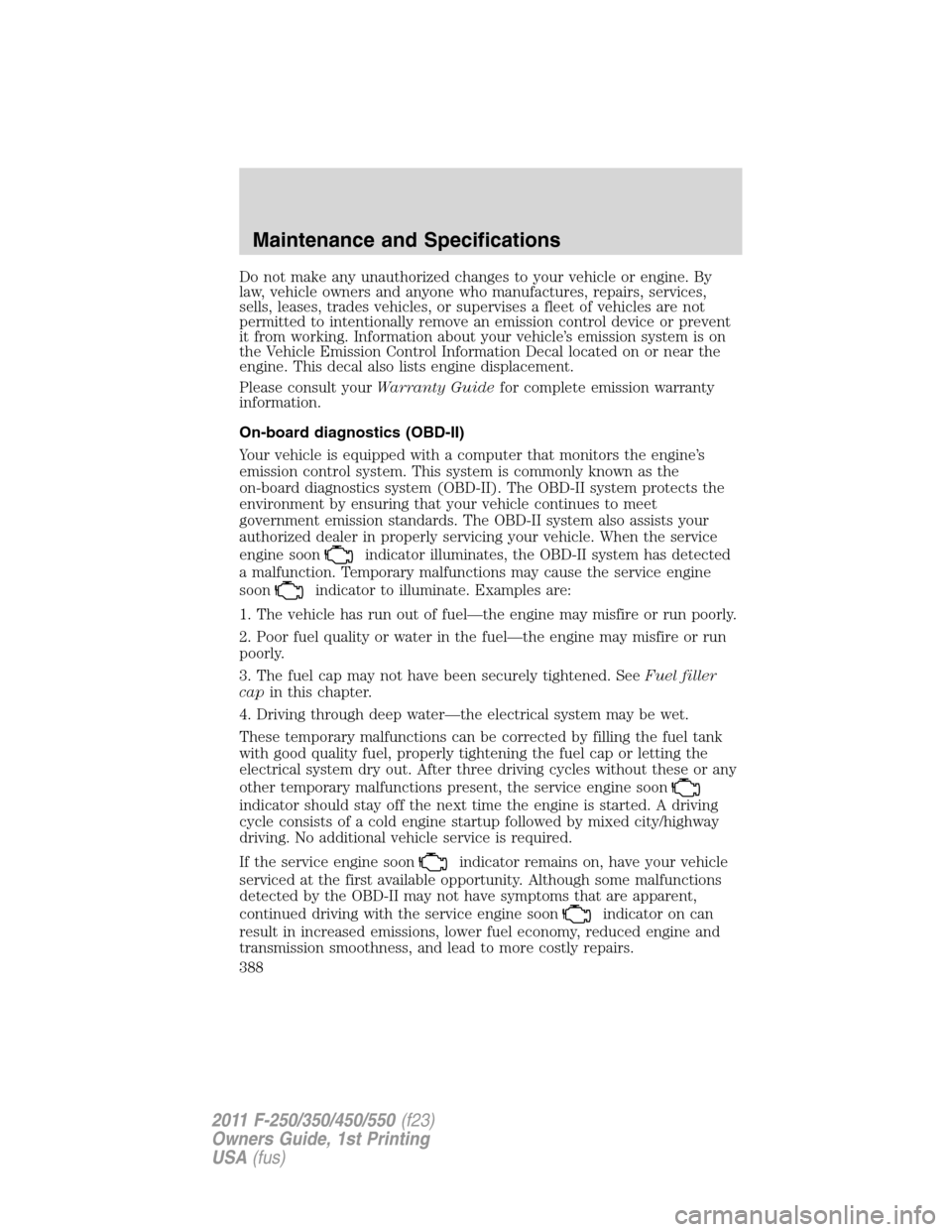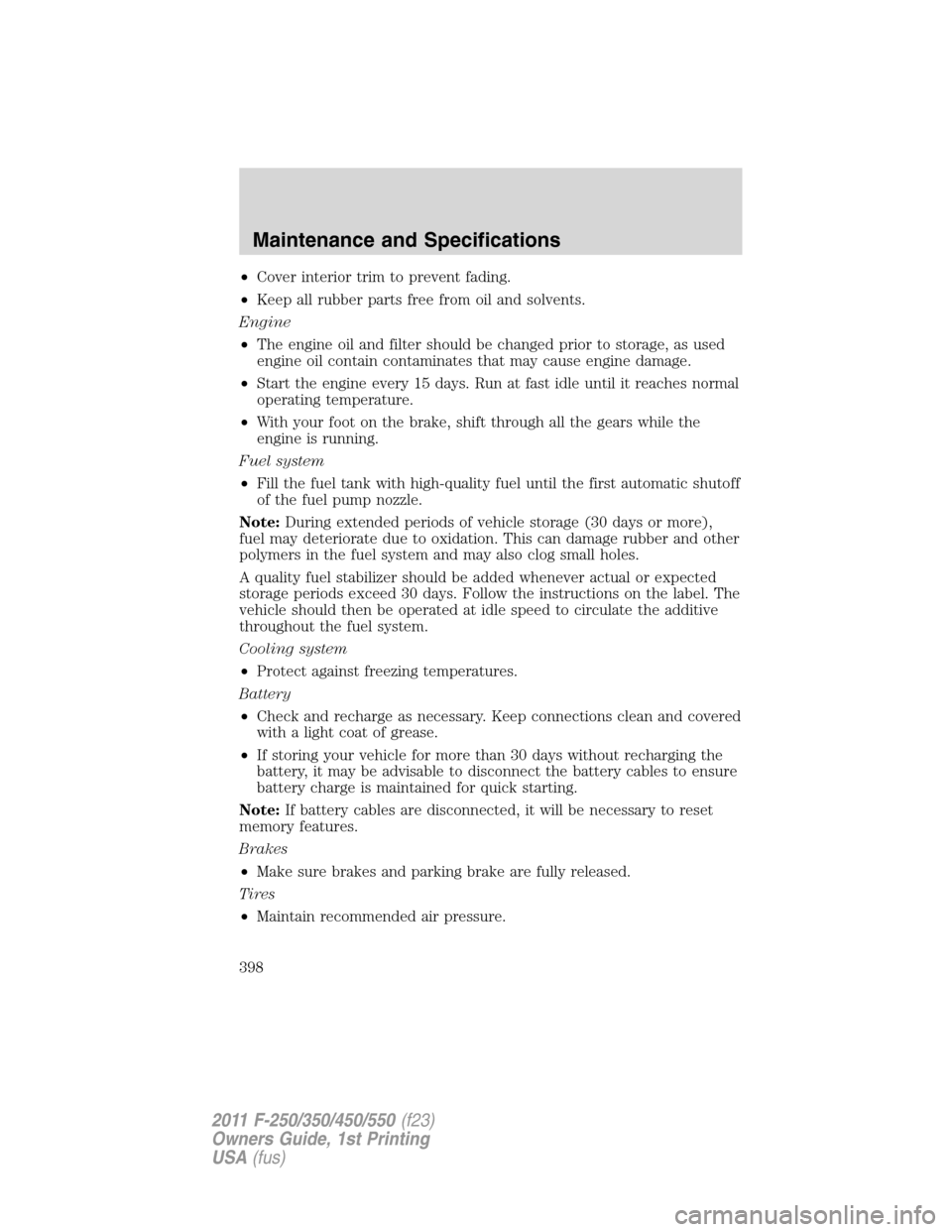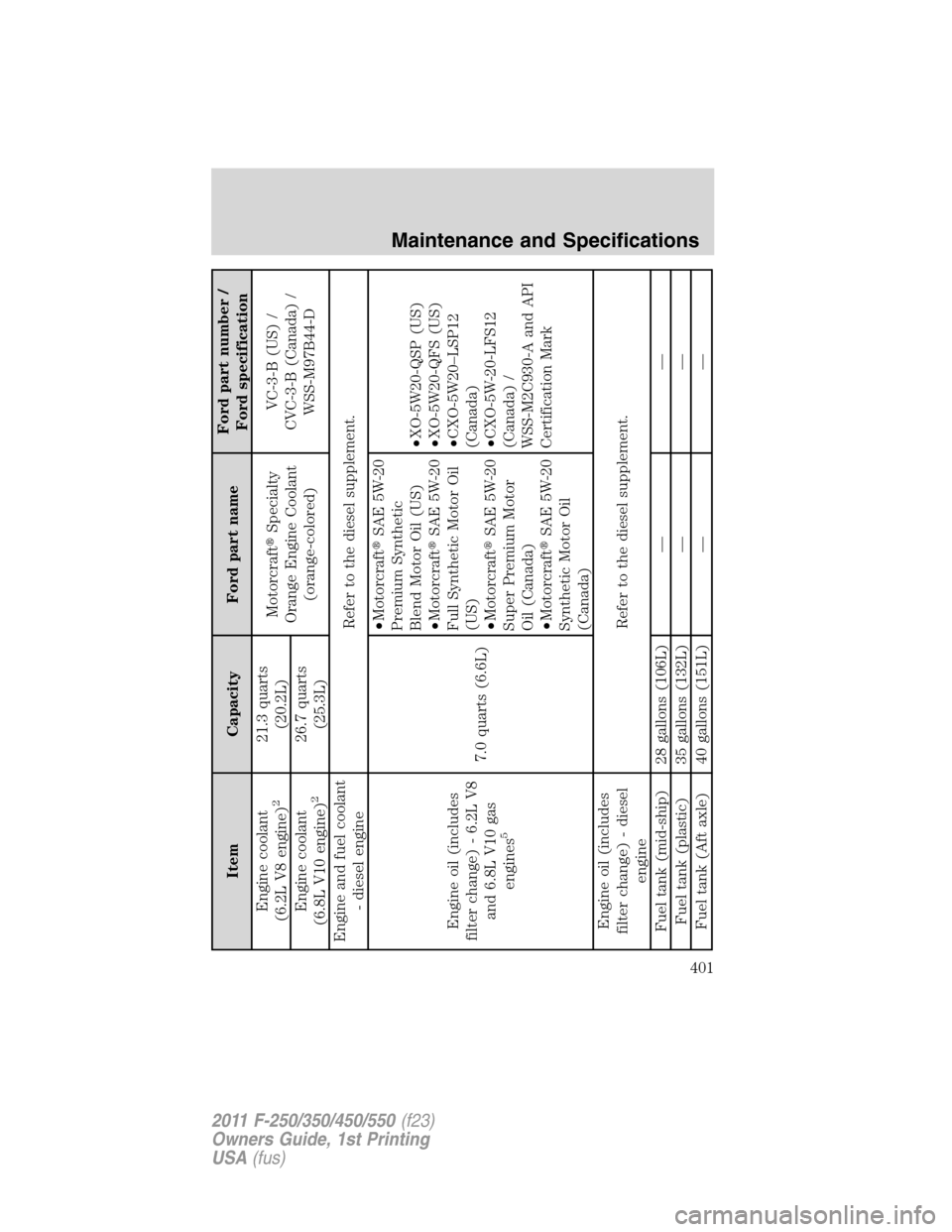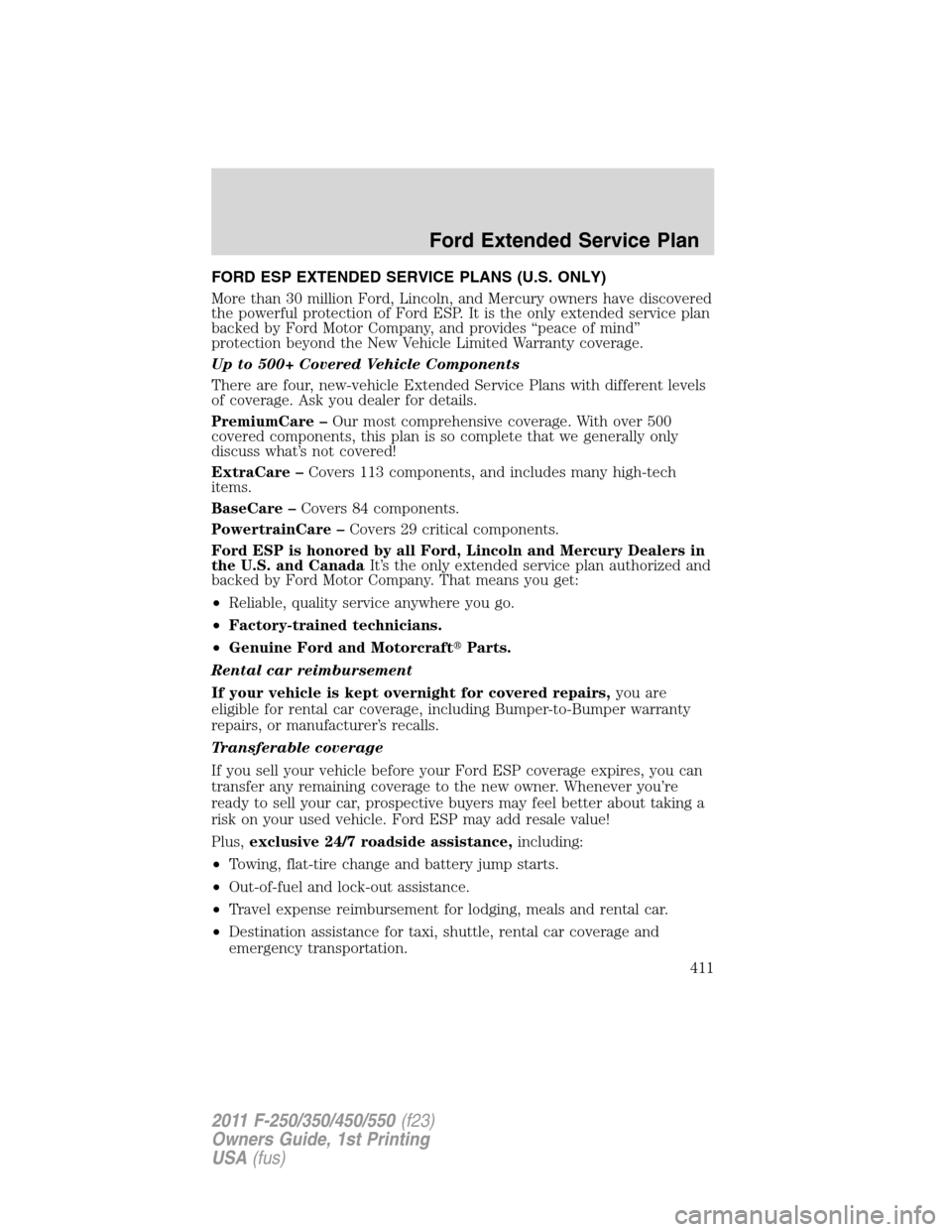Page 388 of 441

Do not make any unauthorized changes to your vehicle or engine. By
law, vehicle owners and anyone who manufactures, repairs, services,
sells, leases, trades vehicles, or supervises a fleet of vehicles are not
permitted to intentionally remove an emission control device or prevent
it from working. Information about your vehicle’s emission system is on
the Vehicle Emission Control Information Decal located on or near the
engine. This decal also lists engine displacement.
Please consult yourWarranty Guidefor complete emission warranty
information.
On-board diagnostics (OBD-II)
Your vehicle is equipped with a computer that monitors the engine’s
emission control system. This system is commonly known as the
on-board diagnostics system (OBD-II). The OBD-II system protects the
environment by ensuring that your vehicle continues to meet
government emission standards. The OBD-II system also assists your
authorized dealer in properly servicing your vehicle. When the service
engine soon
indicator illuminates, the OBD-II system has detected
a malfunction. Temporary malfunctions may cause the service engine
soon
indicator to illuminate. Examples are:
1. The vehicle has run out of fuel—the engine may misfire or run poorly.
2. Poor fuel quality or water in the fuel—the engine may misfire or run
poorly.
3. The fuel cap may not have been securely tightened. SeeFuel filler
capin this chapter.
4. Driving through deep water—the electrical system may be wet.
These temporary malfunctions can be corrected by filling the fuel tank
with good quality fuel, properly tightening the fuel cap or letting the
electrical system dry out. After three driving cycles without these or any
other temporary malfunctions present, the service engine soon
indicator should stay off the next time the engine is started. A driving
cycle consists of a cold engine startup followed by mixed city/highway
driving. No additional vehicle service is required.
If the service engine soon
indicator remains on, have your vehicle
serviced at the first available opportunity. Although some malfunctions
detected by the OBD-II may not have symptoms that are apparent,
continued driving with the service engine soon
indicator on can
result in increased emissions, lower fuel economy, reduced engine and
transmission smoothness, and lead to more costly repairs.
Maintenance and Specifications
388
2011 F-250/350/450/550(f23)
Owners Guide, 1st Printing
USA(fus)
Page 398 of 441

•Cover interior trim to prevent fading.
•Keep all rubber parts free from oil and solvents.
Engine
•The engine oil and filter should be changed prior to storage, as used
engine oil contain contaminates that may cause engine damage.
•Start the engine every 15 days. Run at fast idle until it reaches normal
operating temperature.
•With your foot on the brake, shift through all the gears while the
engine is running.
Fuel system
•Fill the fuel tank with high-quality fuel until the first automatic shutoff
of the fuel pump nozzle.
Note:During extended periods of vehicle storage (30 days or more),
fuel may deteriorate due to oxidation. This can damage rubber and other
polymers in the fuel system and may also clog small holes.
A quality fuel stabilizer should be added whenever actual or expected
storage periods exceed 30 days. Follow the instructions on the label. The
vehicle should then be operated at idle speed to circulate the additive
throughout the fuel system.
Cooling system
•Protect against freezing temperatures.
Battery
•Check and recharge as necessary. Keep connections clean and covered
with a light coat of grease.
•If storing your vehicle for more than 30 days without recharging the
battery, it may be advisable to disconnect the battery cables to ensure
battery charge is maintained for quick starting.
Note:If battery cables are disconnected, it will be necessary to reset
memory features.
Brakes
•Make sure brakes and parking brake are fully released.
Tires
•Maintain recommended air pressure.
Maintenance and Specifications
398
2011 F-250/350/450/550(f23)
Owners Guide, 1st Printing
USA(fus)
Page 401 of 441

Item Capacity Ford part nameFord part number /
Ford specification
Engine coolant
(6.2L V8 engine)
2
21.3 quarts
(20.2L)Motorcraft�Specialty
Orange Engine Coolant
(orange-colored)VC-3-B (US) /
CVC-3-B (Canada) /
WSS-M97B44-D Engine coolant
(6.8L V10 engine)
2
26.7 quarts
(25.3L)
Engine and fuel coolant
- diesel engineRefer to the diesel supplement.
Engine oil (includes
filter change) - 6.2L V8
and 6.8L V10 gas
engines
5
7.0 quarts (6.6L)•Motorcraft�SAE 5W-20
Premium Synthetic
Blend Motor Oil (US)
•Motorcraft�SAE 5W-20
Full Synthetic Motor Oil
(US)
•Motorcraft�SAE 5W-20
Super Premium Motor
Oil (Canada)
•Motorcraft�SAE 5W-20
Synthetic Motor Oil
(Canada)•XO-5W20-QSP (US)
•XO-5W20-QFS (US)
•CXO-5W20–LSP12
(Canada)
•CXO-5W-20-LFS12
(Canada) /
WSS-M2C930-A and API
Certification Mark
Engine oil (includes
filter change) - diesel
engineRefer to the diesel supplement.
Fuel tank (mid-ship) 28 gallons (106L) — —
Fuel tank (plastic) 35 gallons (132L) — —
Fuel tank (Aft axle) 40 gallons (151L) — —
Maintenance and Specifications
401
2011 F-250/350/450/550(f23)
Owners Guide, 1st Printing
USA(fus)
Page 402 of 441
Item Capacity Ford part nameFord part number /
Ford specification
Hinges, latches, striker
plates, fuel filler door
hinge and seat tracks— Multi-Purpose GreaseXG–4 or XL-5 /
ESB-M1C93–B
Lock cylinders —Motorcraft�Penetrating
and Lock LubricantXL-1 / None
Transmission / parking
brake linkages and
pivots, brake pedal shift—Motorcraft�Premium
Long-Life GreaseXG-1-C or XG-1-K /
WSD-M1C227-A
Power steering fluidKeep fluid level
between MIN and
MAX on reservoirMotorcraft�
MERCON�VATFXT-5-QM /
MERCON�V
Transfer case fluid 2.0 quarts (1.9L)Motorcraft�Transfer
Case FluidXL-12 / —
Automatic transmission
fluid
(5–speed)
3
17.5 quarts
(16.6L)
4
Motorcraft�
MERCON�LV AT FXT-10–QLV /
MERCON�LV
Automatic transmission
fluid
(6-speed)
3
18.5 quarts
(17.5L)
4
Maintenance and Specifications
402
2011 F-250/350/450/550(f23)
Owners Guide, 1st Printing
USA(fus)
Page 404 of 441
ENGINE DATA
Engine 6.2L V8 engine 6.8L V10 engine
Cubic inches 378 413
Required fuel 87 octane 87 octane
Firing order 1-3-7-2-6-5-4-8 1-6-5-10-2-7-3-8-4-9
Spark plug gap0.039–0.043 inch
(1.0–1.1mm)0.039–0.043 inch
(1.0–1.1mm)
Ignition system Coil on plug Coil on plug
Compression ratio 9.8:1 9.2:1
Engine drivebelt routing
6.2L V8 engine
6.8L V10 engine with A/C
Maintenance and Specifications
404
2011 F-250/350/450/550(f23)
Owners Guide, 1st Printing
USA(fus)
Page 411 of 441

FORD ESP EXTENDED SERVICE PLANS (U.S. ONLY)
More than 30 million Ford, Lincoln, and Mercury owners have discovered
the powerful protection of Ford ESP. It is the only extended service plan
backed by Ford Motor Company, and provides “peace of mind”
protection beyond the New Vehicle Limited Warranty coverage.
Up to 500+ Covered Vehicle Components
There are four, new-vehicle Extended Service Plans with different levels
of coverage. Ask you dealer for details.
PremiumCare –Our most comprehensive coverage. With over 500
covered components, this plan is so complete that we generally only
discuss what’s not covered!
ExtraCare –Covers 113 components, and includes many high-tech
items.
BaseCare –Covers 84 components.
PowertrainCare –Covers 29 critical components.
Ford ESP is honored by all Ford, Lincoln and Mercury Dealers in
the U.S. and CanadaIt’s the only extended service plan authorized and
backed by Ford Motor Company. That means you get:
•Reliable, quality service anywhere you go.
•Factory-trained technicians.
•Genuine Ford and Motorcraft�Parts.
Rental car reimbursement
If your vehicle is kept overnight for covered repairs,you are
eligible for rental car coverage, including Bumper-to-Bumper warranty
repairs, or manufacturer’s recalls.
Transferable coverage
If you sell your vehicle before your Ford ESP coverage expires, you can
transfer any remaining coverage to the new owner. Whenever you’re
ready to sell your car, prospective buyers may feel better about taking a
risk on your used vehicle. Ford ESP may add resale value!
Plus,exclusive 24/7 roadside assistance,including:
•Towing, flat-tire change and battery jump starts.
•Out-of-fuel and lock-out assistance.
•Travel expense reimbursement for lodging, meals and rental car.
•Destination assistance for taxi, shuttle, rental car coverage and
emergency transportation.
Ford Extended Service Plan
411
2011 F-250/350/450/550(f23)
Owners Guide, 1st Printing
USA(fus)
Page 422 of 441

Every 15,000 miles
(24,000 km)Replace cabin air filter (if equipped)
Every 30,000 miles
(48,000 km)Replace climate-controlled seat filter (if
equipped)
Replace engine air filter
Replace fuel filter (Ranger)
Every 60,000 miles
(96,000 km)Change automatic transmission fluid and filter
on TorqShift�transmission. Consult dealer for
requirements.
Replace front wheel bearing grease and grease
seal on 4x2 vehicles (if non-sealed bearings
are used)
Every 105,000 miles
(168,000 km)Change engine coolant
1
Change manual transmission fluid (all trucks
except Escape)
Change rear axle fluid (Dana axles)
Replace spark plugs
Inspect accessory drive belt(s)
2
Every 150,000 miles
(240,000 km)Change automatic transmission fluid and filter
(filter not required on 6F35, 6F50 and AWF-21
transmissions) except TorqShift�transmission.
Consult dealer for requirements.
Change front axle fluid (4WD vehicles)
Change manual transmission fluid
Change rear axle fluid on all rear-wheel drive
(RWD) vehicles
Change transfer case fluid (4WD vehicles)
Replace accessory drive belt(s) if not replaced
within the last 100,000 miles (160,000 km)
Replace front wheel bearings and seals on 4x2
vehicles (if non-sealed bearings are used)
1Initial replacement at 105,000 miles (160,000 km) or 72 months; every
45,000 miles (80,000 km) or 36 months thereafter
2Perform a follow-up inspection at 120,000 miles (192,000 km)
Scheduled Maintenance Guide
422
2011 F-250/350/450/550(f23)
Owners Guide, 1st Printing
USA(fus)
Page 427 of 441

Extensive idling and/or low-speed driving for long distances as in heavy
commercial use such as delivery, taxi, patrol car or livery
Inspect frequently, service as
required– Replace cabin air filter (if equipped).
– Replace engine air filter.
Every 5,000 miles (8,000 km)– Inspect brake system.
– Rotate tires, inspect tires for wear and measure tread
depth.
– Inspect the wheels and related components for
abnormal noise, wear, looseness or drag.
– Lubricate control arm and steering ball joints (if
equipped with grease fittings).
Every 5,000 miles (8,000 km) or
6 months– Inspect and lubricate U-joints.
Every 5,000 miles (8,000 km),
6 months or 200 hours of engine
operation– Change engine oil and replace oil filter.
Every 15,000 miles (24,000 km)– Replace fuel filter (Ranger).
Every 30,000 miles (48,000 km)– Change automatic transmission fluid (not required on
6R80 or TorqShift�transmissions).
– Replace wheel bearing grease and grease seals on 4x2
front wheel bearings (if non-sealed bearings are used).
Every 60,000 miles (96,000 km)– Replace spark plugs.
– Change transfer case fluid.
Scheduled Maintenance Guide
427
2011 F-250/350/450/550(f23)
Owners Guide, 1st Printing
USA(fus)